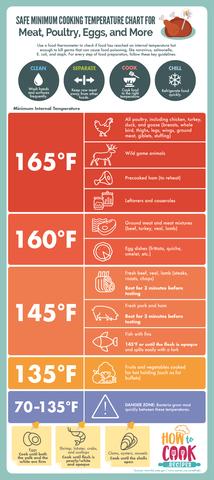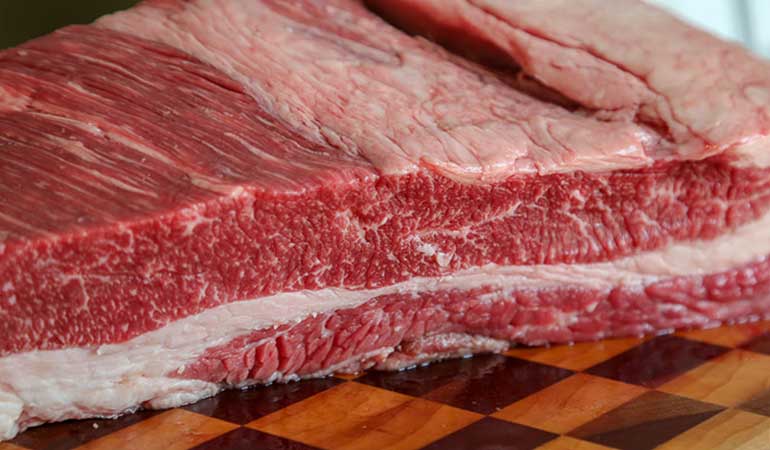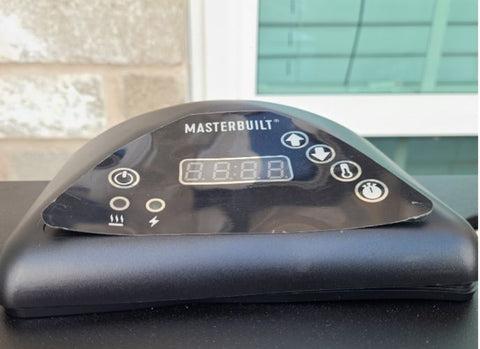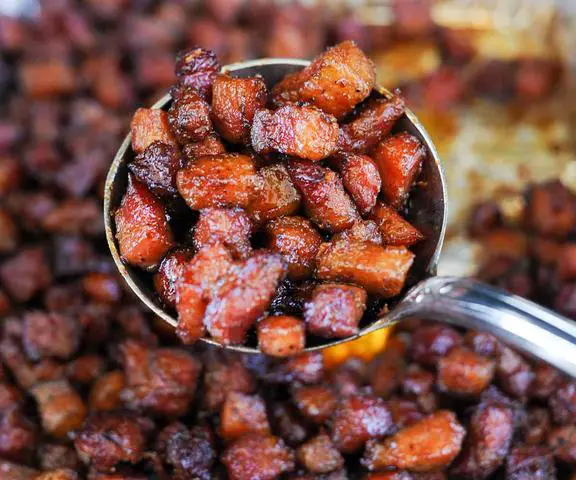
“Perfectly Cook Ground Beef Every Time: Discover the Ideal Temperature and Techniques for Juicy and Flavorful Results!”
Safe Meat Serving Temps
When it comes to beef, it is crucial to cook it to a minimum internal temperature of 160 degrees Fahrenheit. This ensures that any harmful bacteria are killed and reduces the risk of foodborne illnesses. However, for those who prefer their steaks rare or medium-rare, the absolute minimum temperature should be 145 degrees Fahrenheit.

Chicken, being one of the most common meats consumed, must be cooked to an internal temperature of 165 degrees Fahrenheit. Undercooking chicken can lead to severe illnesses caused by salmonella bacteria. It is important to ensure that there are no pink spots in the chicken as this could indicate undercooked meat.
Pork should be cooked to a minimum internal temperature of 145 degrees Fahrenheit. Ground pork, on the other hand, should reach at least 160 degrees Fahrenheit due to its higher risk of bacterial contamination. Pork chops and tenderloins can be challenging to cook perfectly as they need to be cooked all the way through while retaining their juiciness.
Lamb should be cooked to at least 145 degrees Fahrenheit for cuts such as roasts and steaks. Cubes or ground lamb patties should have no pink in them and must be thoroughly cooked in order to prevent bacterial contamination.
Fish, including salmon, should have an internal temperature of at least 145 degrees Fahrenheit when cooking low and slow. Raw fish dishes like sushi carry a higher risk of spreading Listeria bacterium and pregnant women should exercise caution when consuming them.
Beef
When it comes to cooking beef, it is important to ensure that it reaches a safe internal temperature to prevent foodborne illnesses. Fresh beef should be cooked to at least 160 degrees Fahrenheit, although the minimum recommended temperature is 145 degrees. Resting the meat for a few minutes after reaching the desired temperature allows the juices to redistribute, resulting in a more tender and juicy meal. Cooking beef can be challenging, especially when aiming for rare or medium-rare steaks. Using a food thermometer is essential to achieve perfectly cooked steaks and ensure food safety.
Consider Rest Time
When grilling beef, it is important to consider rest time. This is the final stretch of the grilling process where you allow the meat to consistently reach its final temperature. It is recommended to let the meat rest for about 3 minutes at a consistent temperature before removing it from the grill. Resting meat allows the juices to soak back into the cut, resulting in a more tender and juicy meal.
Beef can be a tricky meat to cook, especially when it comes to achieving rare or medium-rare steaks. To ensure safety, fresh beef should be cooked to at least 160 degrees Fahrenheit. The absolute minimum is 145 degrees, but it’s best not to risk undercooking it. Some cuts of beef, like brisket, are cooked or smoked well past this point and usually reach temperatures over 200 degrees. Using a food thermometer can help you achieve that perfectly cooked steak.
Chicken is one of the most common meats found on American kitchen tables, but it can be challenging to cook without overcooking or undercooking it. Undercooked chicken can lead to severe illnesses caused by bacteria such as salmonella. It is crucial to cook chicken to an internal temperature of at least 165 degrees Fahrenheit to ensure it is safe for consumption. Even slight pink spots in chicken could lead to illness, so it’s important not to take any risks.
Cooking dark and white chicken meat requires different approaches due to their varying fat content and flavors. Chicken thighs should be slow-roasted or cooked at lower temperatures for longer periods compared to chicken breasts. The fat content in thighs gives them their juicy flavor. On the other hand, chicken breasts can be cooked quicker and at higher temperatures. It’s essential not to cook chicken breasts at too high of a temperature to avoid ending up with a raw center.
Cooking pork can be challenging, as it requires achieving the desired level of juiciness while ensuring it is cooked all the way through. Pork chops are best when cooked thoroughly while retaining their juiciness. It is recommended to cook any slab of pork, including ground pork, to at least an internal temperature of 145 degrees Fahrenheit. When testing the temperature, make sure to insert the thermometer in the thickest part of the meat. Additionally, timing is key when cooking pork tenderloin or roast, and slow cooking methods can yield tender and juicy results.
Lamb is a delicate and tasty meat that needs to be cooked carefully and well for safe consumption. Different cuts of lamb require different cooking methods and temperatures. Cubes or ground lamb patties should have no pink in them, while a roast can have a slight pink color. It is crucial to sear the outside of a roast at a hot enough temperature to eliminate any bacteria. Following USDA recommendations for proper lamb cooking is highly recommended.
Fish, such as salmon, requires careful handling and cooking to ensure it is safe to eat. The internal temperature of fish should reach at least 145 degrees Fahrenheit. Raw fish dishes like sushi carry the risk of spreading bacteria such as Listeria, particularly for pregnant women. Buying fish from reputable stores and following proper cooking methods (baking, grilling, or pan frying) can help ensure its safety.
To prevent undercooked meat and ensure food safety, using an accurate thermometer is highly recommended. Most meats need to be cooked to at least 145 degrees Fahrenheit to eliminate harmful bacteria. Finding a reliable thermometer will help you measure the internal temperature accurately and cook your meat safely.
Use A Food Thermometer with Beef
When it comes to grilling beef, it is crucial to use a food thermometer to ensure that it reaches the appropriate internal temperature. Fresh beef should be cooked to at least 160 degrees Fahrenheit, although the absolute minimum is 145 degrees. Resting the meat for a few minutes after reaching the desired temperature allows the juices to soak back into the cut, resulting in a more tender and juicy meal. It is important to note that beef is a tricky meat to cook, especially if you prefer rare steaks. Using a food thermometer can help you achieve the perfect level of doneness without risking undercooking or overcooking.
Chicken is one of the most common meats found on Americans’ kitchen tables, but it can be challenging to cook it properly without overcooking or undercooking. Undercooked chicken can lead to severe illnesses, so it is crucial to cook chicken thighs and breasts to an internal temperature of 165 degrees Fahrenheit. Dark meat like chicken thighs should be slow-roasted or cooked at lower temperatures for longer durations, while white meat like chicken breasts can be cooked quicker and at higher temperatures. Taking these differences into consideration when cooking chicken will help ensure that it is safe and delicious.
Pork chops are known for their juicy flavor, but they can easily become tough and dry if overcooked. To avoid this, pork chops should be cooked until they reach an internal temperature of at least 145 degrees Fahrenheit. Ground pork, on the other hand, should be cooked to at least 160 degrees Fahrenheit. When cooking pork tenderloin or roast, timing is key. Slow roasting or using a slow cooker can result in tender and juicy pork, while cooking for at least 25 minutes per pound at a steady temperature of 375 degrees Fahrenheit can also yield delicious results. Using a food thermometer to check the internal temperature is essential for perfectly cooked pork.
Lamb is a delicate and tasty meat that requires careful cooking to ensure both safety and flavor. When cooking lamb, it is recommended to cook it to at least 145 degrees Fahrenheit, or 165 degrees Fahrenheit for lamb chops. Different cuts of lamb may require different cooking methods, with cubes or ground lamb patties needing no pink and roasts allowing for a slight pinkness. It is important to sear the outside of a roast properly to eliminate any bacteria. Following the USDA recommendations for cooking lamb will help you enjoy this meat safely.
Cooking fish can be tricky, as it needs to be cooked thoroughly without becoming dry or overcooked. The internal temperature of fish should reach at least 145 degrees Fahrenheit, ensuring that it is safe to consume. This applies not only to salmon but all types of fish. Whether baking, grilling, or pan-frying fish, using a food thermometer will help you achieve the desired level of doneness and prevent undercooking or raw centers. It is especially important when consuming raw fish such as sushi to ensure proper cooking temperatures and avoid the risk of bacterial contamination.
Chicken/TurkeySafe Doneness Temperatures
When it comes to cooking chicken and turkey, it is crucial to ensure that they are cooked to a safe internal temperature to avoid any risk of foodborne illness. The recommended safe doneness temperature for chicken and turkey is 165 degrees Fahrenheit. This temperature ensures that any harmful bacteria present in the meat are killed, making it safe for consumption.
Undercooking chicken or turkey can lead to serious illnesses such as salmonella poisoning, which can cause symptoms like vomiting, diarrhea, and abdominal cramps. It is important to note that even slight pink spots in chicken or turkey can indicate undercooking and should not be ignored. To ensure the safety of your family and guests, always use a food thermometer to accurately measure the internal temperature of the meat.
Devastating Numbers of Raw Chicken Consumption
Every year, approximately 1 million cases of people consuming raw and undercooked chicken are reported. These illnesses can be devastating, causing severe sickness that can leave individuals bedridden for up to 24 hours or even result in hospitalization. It is crucial to cook chicken to an internal temperature of 165 degrees Fahrenheit to ensure it is safe for consumption. Even small pink spots in chicken should not be taken lightly, as they could lead to illness.
Resting meat after cooking is a crucial step in the grilling process. It allows the juices to soak back into the cut, resulting in a more tender and juicy meal. When cooking beef, such as steaks or brisket, it is essential to consider rest time. Instead of immediately removing the meat from the grill once it reaches the desired temperature (at least 160 degrees Fahrenheit for beef), let it rest for about 3 minutes at a consistent temperature. This will ensure that the meat is evenly cooked and flavorful.
Cooking pork can be challenging, as overcooking can lead to dryness while undercooking poses health risks. It is recommended to cook pork cuts, such as tenderloin or roast, to an internal temperature of at least 145 degrees Fahrenheit. Ground pork should be cooked to at least 160 degrees Fahrenheit. To avoid overcooking and achieve juiciness, it is important not to rush the cooking process and follow specific timing guidelines based on the weight of the pork cut.
Correct Temperature for Cooking Raw Chicken
Cooking chicken to the correct temperature is crucial to avoid foodborne illnesses. The recommended internal temperature for cooking raw chicken is 165 degrees Fahrenheit. This ensures that any harmful bacteria, such as salmonella, are killed and the chicken is safe to consume. Undercooking chicken can lead to severe illness, including gastrointestinal symptoms and dehydration. It is important to use a food thermometer to accurately measure the internal temperature of the chicken during cooking.
Chicken Thighs Vs. Chicken BreastsDoneness Temperature
Cooking chicken thighs and chicken breasts to the correct temperature is crucial to ensure they are safe to eat. The recommended internal temperature for chicken is 165 degrees Fahrenheit. Undercooking chicken can lead to illnesses caused by harmful bacteria, while overcooking can result in dry and tough meat.
When cooking chicken thighs, it is best to slow-roast or cook them at a lower temperature for a longer time. This allows the fat content in the thigh to render and infuse the meat with juicy flavors. On the other hand, chicken breasts can be cooked quicker and at higher temperatures. It is important not to cook chicken breasts at too high of a temperature, as this may result in a raw center that doesn’t get a chance to cook through properly.
What About Turkey?
Cooking turkey requires the same attention as cooking chicken. It is important to cook it to an internal temperature of 165 degrees Fahrenheit to ensure that it is safe to eat. Many people enjoy turkey during holidays like Thanksgiving, but it is crucial to make sure that it is cooked thoroughly to avoid any risk of foodborne illnesses.
PorkDoneness Temperature
Cooking pork to the correct internal temperature is crucial to ensure it is safe to eat. The recommended minimum internal temperature for pork is 145 degrees Fahrenheit. However, ground pork should be cooked to a slightly higher temperature of at least 160 degrees Fahrenheit. It is important to use a food thermometer to accurately measure the internal temperature of the pork.
Cooking pork chops can be challenging as you want them to be cooked all the way through without becoming tough and dry. To achieve juicy and tender pork chops, it is essential to cook them until they reach an internal temperature of 145 degrees Fahrenheit. It is recommended to cook pork chops for about 25 minutes per pound at a steady temperature of 375 degrees Fahrenheit.
When cooking a pork tenderloin or roast, timing is key. Slow cooking methods such as using a slow cooker or roasting in the oven at low temperatures for several hours can result in tender and juicy pork. It is important to ensure that the internal temperature of the tenderloin or roast reaches at least 145 degrees Fahrenheit before serving.
What Temperature Should Pork Be Cooked At?
Pork should be cooked to an internal temperature of at least 145 degrees Fahrenheit. This ensures that the meat is safe to eat and free from harmful bacteria. Ground pork, however, should be cooked to a slightly higher temperature of 160 degrees Fahrenheit to ensure thorough cooking. It is important to use a food thermometer to accurately measure the internal temperature of the pork and avoid overcooking or undercooking.
Cooking pork can be challenging as it requires finding the right balance between cooking it all the way through and retaining its juiciness. It is recommended to cook pork chops for at least 25 minutes per pound at a steady temperature of 375 degrees Fahrenheit. Resting time is also crucial for pork, allowing the juices to redistribute and create a more tender and flavorful meal.
When cooking pork tenderloin or roast, slow cookers or slow roasters can be used for up to 8 hours. The key is not rushing the cooking process and ensuring that the internal temperature reaches at least 145 degrees Fahrenheit. Different cuts of pork may vary in thickness and density, so grilling times may differ from roasting in the oven. It is important to check a reliable chart for exact cooking times based on different cuts of pork.
Overall, cooking pork at the right temperature is essential for both safety and taste. By following these guidelines and using a food thermometer, you can enjoy juicy and perfectly cooked pork dishes every time.
How To Cook Pork Tenderloin and Roast
Cooking pork tenderloin and roast can be a bit tricky, but with the right techniques, you can achieve a juicy and flavorful result. When cooking a pork tenderloin or roast, it is important to ensure that it reaches an internal temperature of at least 145 degrees Fahrenheit. To achieve this, it is recommended to cook the meat for at least 25 minutes per pound at a steady temperature of 375 degrees Fahrenheit.
If you don’t have enough time to slow roast the entire tenderloin or roast for several hours, you can also use a slow cooker or slow roaster. These methods can take up to 8 hours but result in tender and juicy pork. Regardless of the cooking method you choose, always remember to insert the thermometer in the thickest part of the meat to ensure it is cooked through.
Grilling vs. Oven Roasting Pork
When it comes to cooking pork, there are two popular methods: grilling and oven roasting. Grilling pork is a great option for those who enjoy the smoky flavor and charred exterior that comes from cooking over an open flame. It can be a bit tricky to get the timing right, as grilling temperatures can fluctuate, but with practice, you can achieve deliciously tender and juicy pork chops or tenderloin. On the other hand, oven roasting is a more controlled method of cooking pork. By cooking at a steady temperature in the oven, you can ensure even cooking and avoid overcooking or drying out the meat.
Both grilling and oven roasting have their advantages and it ultimately comes down to personal preference. Grilling offers that unique smoky flavor and charred exterior, while oven roasting allows for more control over the cooking process. Whichever method you choose, make sure to cook pork to at least an internal temperature of 145 degrees Fahrenheit to ensure it is safe to eat.
Lamb Doneness Temperature
Cooking lamb carefully and well is important to enjoy safely. If you are looking to cook or grill a lamb delicacy in your own home, be sure to cook it to at least 145 degrees or 165 degrees Fahrenheit for lamb chops. Like I mentioned above, cook the lamb differently for different cuts. Cubes or ground lamb patties must have no pink, whereas a roast can have a slight pink in them. Always be sure that the outside of a roast is seared hot enough to get rid of any lingering bacteria. The best guide to follow is the USDA recommendations for how to properly cook your lamb. Lamb can be tricky to master but I have absolute faith in you.
How To Cook Lamb at Home
Cooking lamb at home can be a delicious and satisfying experience. To ensure that your lamb is cooked safely, it is important to follow proper cooking guidelines. The USDA recommends cooking lamb to an internal temperature of at least 145 degrees Fahrenheit for roasts, and 165 degrees Fahrenheit for lamb chops. It is also important to sear the outside of a roast to eliminate any bacteria.
When cooking different cuts of lamb, it is important to adjust your cooking method accordingly. Cubes or ground lamb patties should have no pink in them, while a roast can have a slight pinkness. Always remember to use a reliable thermometer to check the internal temperature of the meat.
If you are unsure about how to cook lamb properly, consult the USDA’s recommendations or seek out trusted recipes and sources for guidance. With practice and attention to detail, you can enjoy perfectly cooked and safe-to-eat lamb dishes in your own home.
The Rise of Food Poisoning From Lamb: Cooking Diced vs. Chops
Cooking lamb can be tricky, especially when it comes to ensuring that it is cooked thoroughly to avoid food poisoning. One common mistake is assuming that pink lamb is safe to eat as long as the outside is cooked. While this may be true for seared lamb roasts, it is not the case for shredded or ground lamb. The bad bacteria that can cause contamination are often found on the outside of raw lamb, and when the meat is shredded or chopped, these bacteria can spread throughout the entire dish if not cooked properly.
When cooking diced lamb or lamb chops, it is crucial to cook them to an internal temperature of at least 145 degrees Fahrenheit. This ensures that any harmful bacteria are killed off and reduces the risk of food poisoning. However, it’s important to note that different cuts of lamb may require different cooking times and temperatures. For example, a roast can have a slight pink center while still being safe to eat, but cubes or ground lamb patties should have no pink at all.
FishDoneness Temperature

Cooking fish properly is crucial to ensure it is safe and enjoyable to eat. A common favorite, such as salmon, requires careful cooking techniques to prevent undercooking or rawness in the middle. To achieve the desired doneness, it is recommended to cook fish until its internal temperature reaches at least 145 degrees Fahrenheit. While some individuals may prefer a higher temperature, the minimum recommended by the USDA is 145 degrees.
When preparing raw fish dishes like sushi or smoked salmon, it is important to be cautious of the Listeria bacterium and its potential spread. Pregnant women should especially avoid consuming raw fish due to the risk it poses to both themselves and their unborn child. Cooking fish at home can be relatively safe and straightforward if proper precautions are taken. Start by purchasing fresh fish from a reputable store and choose your preferred cooking method – baking in the oven, grilling, or pan frying. Regardless of the method chosen, make sure to flip the fish evenly during pan frying for a golden-brown crust and use a reliable thermometer to ensure that the internal temperature reaches at least 165 degrees for optimal safety.
The Correct Cooking Temperature for Fish
Fish, like any other meat, needs to be cooked to a safe internal temperature to prevent the risk of foodborne illnesses. The recommended cooking temperature for fish is at least 145 degrees Fahrenheit. This ensures that any harmful bacteria or parasites present in the fish are killed off. It is important to use a reliable food thermometer to check the internal temperature of the fish before consuming it.
There are various methods to prepare fish, such as baking, grilling, or pan frying. Regardless of the cooking method, it is crucial to ensure that the fish reaches the minimum internal temperature of 145 degrees Fahrenheit. This will guarantee that the fish is fully cooked and safe to eat. Overcooking can result in dry and tough fish, so it’s essential to monitor the temperature closely and remove the fish from heat once it reaches the desired temperature.
When cooking fish, especially raw or undercooked seafood like sushi or smoked salmon, extra caution should be taken due to potential risks of Listeria contamination. Pregnant women should be particularly careful when consuming raw fish as it can pose a risk to their health and that of their unborn child. By following proper cooking temperatures and handling practices, you can enjoy delicious and safely cooked fish at home.
Eating and Preparing Raw Fish, Is it Safe?
When it comes to eating and preparing raw fish, there are some safety considerations to keep in mind. Raw fish, such as sushi or sashimi, can carry the risk of bacterial contamination, particularly from the Listeria bacterium. Pregnant women should be especially cautious when consuming raw fish due to the potential harm it can cause to both them and their unborn child.
Cooking fish at home is generally considered safe as long as you follow proper food handling practices. It is important to purchase your fish from a reputable store to ensure its freshness and quality. There are various methods you can use to prepare fish, including baking, grilling, or pan frying. Regardless of the method you choose, make sure that the internal temperature of the fish reaches at least 165 degrees Fahrenheit to ensure it is cooked thoroughly and free from harmful bacteria.
How to Cook Fish
Cooking fish at home is relatively safe and easier than you may think. The most important and very first step is to buy your fish from a reputable store. This way you are starting with good fish, to begin with. Then, there are multiple ways to prepare it. You can either bake it in the oven, grill it or pan fry it. Just be sure that when you are pan-frying it that you flip the fish at least once or twice to get a nice golden-brown crust. Use a temperature gauge to make sure it reaches 165 degrees internally.
Conclusion

Cooking meat to the appropriate internal temperature is crucial to ensure it is safe to consume and free of harmful bacteria. Different types of meat require different cooking temperatures for optimal doneness. Beef should be cooked to at least 160 degrees Fahrenheit, while chicken should reach a minimum of 165 degrees Fahrenheit. Pork should be cooked to an internal temperature of 145 degrees Fahrenheit, and lamb should reach at least 145 degrees Fahrenheit for roasts and 165 degrees Fahrenheit for lamb chops. Fish should be cooked to at least 145 degrees Fahrenheit as well.
Using a food thermometer is highly recommended to accurately measure the internal temperature of meat and prevent undercooking or overcooking. Resting meat after cooking allows the juices to redistribute, resulting in a more tender and flavorful meal. It’s important to follow these guidelines to avoid foodborne illnesses and ensure a safe dining experience for yourself and your loved ones.
In conclusion, properly cooking ground beef is essential to ensure food safety. The recommended internal temperature of 160°F (71°C) should be reached to kill any harmful bacteria. By using a meat thermometer and following safe cooking practices, you can enjoy delicious and safe ground beef dishes every time.
Learn More About Grilling
If you want to learn more about grilling, check out these other helpful resources!










